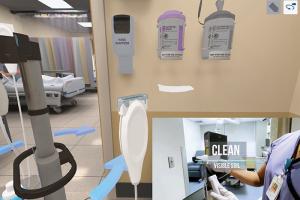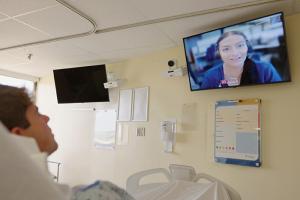Driving health care technology decisions
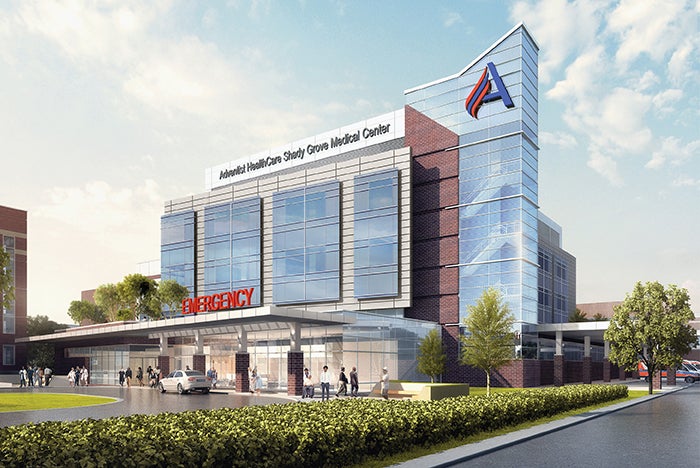
Projects like Adventist HealthCare Shady Grove Medical Center in Rockville, Md., demonstrate what’s possible when planning, integration and innovation are prioritized.
Image courtesy of Wilmot Sanz
Technology is vital in enhancing patient care, streamlining operations and driving cost efficiencies. Yet integrating new technologies into health care facilities is a complex endeavor that demands thoughtful planning, cross-functional collaboration and strategic decision-making to avoid costly setbacks and maximize long-term organizational value. At the heart of this effort lies the comprehensive technology roadmap.
This essential tool guides the implementation of new technologies and helps health care executives understand both short- and long-term financial impacts, enabling smarter, more effective investments. A well-structured roadmap aligns information technology (IT) goals with clinical priorities, eliminates redundancies and strengthens department decision-making. It also supports hospital staff and patient engagement by providing solutions that integrate seamlessly across every touchpoint of the patient care plan.
Before organizations realize these benefits, they must confront the unique challenges of incorporating emerging technologies into established, often fragmented health care environments — each with its own legacy systems and operational constraints.
Key technology challenges
Integrating new technologies into hospitals introduces several challenges. One of the most persistent is confusion over contractor-furnished versus owner-furnished technologies. This ambiguity often leads to scope gaps, costly retrofits and project delays without clear communication and clearly defined responsibilities across teams, consultants and vendors.
Modern smart building technologies — such as building automation systems, advanced lighting systems, nurse call integrations, real-time location systems (RTLSs) and virtual care technologies — not only offer immense promise but also increasing complexity. These systems frequently require legacy infrastructure upgrades and demand early alignment with clinical workflows to maximize value and avoid operational disruptions. Without early stakeholder engagement, critical details, such as device placement, software compatibility, infrastructure impact and network prioritization, may be overlooked.
Moreover, the growing reliance on bedside technologies — such as artificial intelligence (AI)-assisted fall prevention systems, ambient listening devices and predictive monitoring — places significant strain on existing networks and ongoing technical support. Most health care facilities operate on 10-gigabyte (GB) networks, which are increasingly insufficient for today’s data-heavy demands, especially when video-based tools and real-time analytics are involved. Upgrading to 40GB- or even 100GB-capable systems may soon become necessary to support future-ready care environments.
For example, Adventist HealthCare Shady Grove Medical Center in Rockville, Md., implemented virtual telesitting and is exploring video analytics for fall-risk detection. While these advancements enhance patient safety and staffing efficiency, they also highlight the importance of ensuring system security, bandwidth capacity and integration with broader IT infrastructure.
Similarly, Boca Raton (Fla.) Regional Hospital, a Baptist Health South Florida facility, has pioneered a highly personalized patient experience. Features such as interactive televisions for virtual visits and concierge services, bedside room temperature and an integrated RTLS are transforming patient care — but only through meticulous planning, stakeholder alignment and backend coordination across multiple departments and vendors. This level of integration demands foresight and requires agility to adapt to evolving clinical and operational needs.
These technological implementations underscore the urgent need for comprehensive system integration and database coordination, which also must address the growing cybersecurity risks associated with connected medical devices and patient data.
System integration and security
Mid-sized health care projects often struggle with coordinating disparate systems. Consider a Tennessee hospital implementing RTLS to track patients and staff, with data feeding into the electronic health record (EHR); nurse call workflow solution; medical equipment alerts; and wireless phones. Such integration requires precise alignment between clinical processes and facility and IT systems. Their early coordination, clinical use cases and detailed interoperability mapping help avoid costly delays, underperformance or even system failure.
Beyond integration, cybersecurity has emerged as a critical concern. Building automation systems are increasingly tied to sensitive hospital networks as they grow more sophisticated. Many systems were initially developed for typical commercial building use and lack the robust safeguards necessary for health care settings, where HIPAA and California Department of Health Care Access and Information compliance are not negotiable. Complicating matters further, bidding subcontractors often lack health care-specific network knowledge and may not fully understand the stakes involved in data breaches or operational downtime.
Installing automation technologies without proper planning can expose hospitals to breaches or ransomware attacks. Thus, IT departments must rigorously evaluate every new system. This process can take weeks or even months. These timelines must be factored into the project’s critical path to avoid delays. Network segmentation, endpoint protection and vulnerability assessments must be baked into the implementation process, not treated as afterthoughts.
A well-developed technology roadmap anticipates and proactively addresses these risks, enabling safe integration and long-term resilience. With security concerns accounted for, leadership engaged and front-line staff supported, facilities can shift their focus toward designing for adaptability, maximizing return on investment (ROI) and avoiding disruptive, reactive upgrades through coordinated, enterprisewide planning and informed decision-making. Scalability, continuity and operational alignment must be foundational pillars for any future-ready health care technology strategy.
Building the roadmap
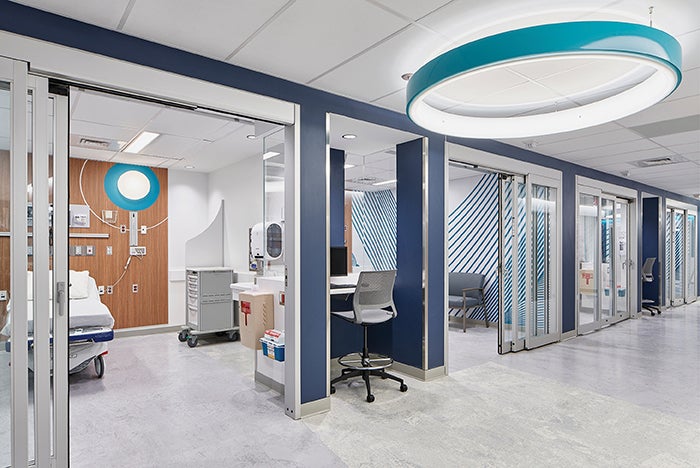
A technology roadmap also helps align infrastructure with clinical priorities and patient expectations in critical areas such as these emergency department rooms.
Image of RWJBarnabas Health Community Medical Center Emergency Department Alteration courtesy of Jeffrey Totaro
In today’s fast-evolving health care environment, technology planning is no longer optional but essential. A comprehensive technology roadmap is more than a checklist; it’s a strategic tool that guides decision-making, mitigates risk and supports long-term success. Whether it’s integrating complex systems, optimizing infrastructure or fostering organizational alignment, a well-executed roadmap helps health care leaders prepare for the future while maximizing today’s investments. Some key benefits include:
Avoiding costly retrofits and “forklift” upgrades. One significant benefit of a technology roadmap is its ability to reduce the need for forklift upgrades — large, costly overhauls when outdated systems must be replaced all at once. By anticipating emerging technologies, health care facilities can design flexible infrastructure that evolves alongside innovation.
Boca Raton Regional Hospital provides a strong example. Its patient rooms were built with integrated bedside temperature controls, virtual visitation, electronic whiteboards, a digital room status display and expandable infrastructure — all designed to accommodate future enhancements. This strategic foresight helps the hospital avoid disruptive renovations and unnecessary costs as technology changes.
By embedding adaptability into the design phase, hospitals can avoid reactive spending and support continuity of care during transitions.
Optimizing infrastructure investments. A technology roadmap also helps align infrastructure with clinical priorities and patient expectations. This avoids redundancy and ensures that new systems support measurable outcomes. For example, a hospital in Tennessee built a patient experience command center that integrates patient apps, EHRs, nurse call, RTLS and security systems. It enables staff to track patients from their initial appointment through treatment and into recovery, streamlining care and improving the patient journey.
Without a roadmap, health care facilities risk miscommunication between departmental teams, scope creep or missed opportunities for integration. A facility’s technical team and departmental leaders may address an operational need with two different technologies, creating redundant solutions that can be costly and disruptive. Technology visioning sessions held early in the planning process are vital to uncovering future infrastructure requirements and aligning them with operational goals.
Facilitating vendor and system integration. Hospitals often work with multiple vendors across disciplines — from nurse call and lighting to digital displays and real-time data systems. Without a clear strategy, integration efforts can be inefficient and costly.
Boca Raton Regional Hospital tackled this by connecting its EHRs with a RTLS and digital patient room displays. These replaced traditional whiteboards and provided real-time data-sharing across teams. At Shady Grove Medical Center, integrating video analytics with virtual telesitting helped reduce staff burden and improved patient monitoring. These solutions succeeded because system compatibility was addressed upfront. A roadmap provides this structure, minimizing interface issues and ensuring cohesive implementation.
Enabling effective resource allocation. New technologies demand support. Implementation must be paired with maintenance, training and dedicated personnel to ensure success. A roadmap establishes a staffing plan, aligns timelines and defines accountability for ongoing system management.
Some facilities have embraced a “biomed geek squad” model, deploying a dedicated technical team to maintain equipment and troubleshoot issues. This helps ensure technologies perform as intended from Day 1. Conversely, hospitals without this preparation often struggle as systems go underutilized due to a lack of knowledge or support.
Energy and automation systems also illustrate this gap. Facilities frequently invest in building automation or energy management tools, only to see them fall short due to untrained staff or underused features. A roadmap reframes these systems as integral components of operations as opposed to isolated tools, helping facilities realize their full value.
Promoting collaboration and stakeholder alignment. Technology planning cannot exist in silos. It requires collaboration across clinical, operational, IT and executive leadership. A roadmap functions as a shared vision, ensuring that all parties move in the same direction.
Technology steering committees are essential to this process. They provide oversight, prioritize projects and ensure that initiatives align with institutional goals such as patient safety, efficiency and regulatory compliance. Without such structures, organizations risk fragmented decisions that undermine outcomes.
By bringing stakeholders together early and often, a roadmap fosters transparency, reduces rework and supports shared accountability. It transforms disparate efforts into a unified, strategic approach.
Creating a living strategy that evolves. Most importantly, a technology roadmap is not a static document. It must be dynamic and adapted continuously to reflect changes in health care delivery, patient needs and technological advancement. Facilities that regularly revisit and revise their roadmaps gain agility and remain ready for what’s next.
Measuring success
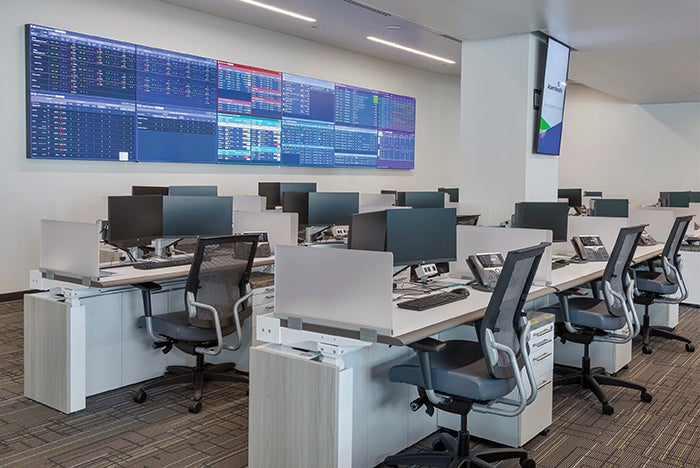
A comprehensive technology roadmap guides decision-making, mitigates risk and supports long-term success, resulting in innovative spaces such as this command center.
Image of AdventHealth Orlando Command Center courtesy of Larry Taylor
When executed effectively, a technology roadmap yields measurable results across clinical, operational and financial metrics. Advanced technologies like AI, predictive analytics and machine learning unlock powerful data insights that optimize care delivery, staffing and facility management while enabling better forecasting, enhanced safety measures and more responsive patient-centered environments.
Success, however, depends on ongoing evaluation and strong leadership engagement. ROI can stem from lower readmission rates, reduced infections or streamlined workflows, but these outcomes only materialize when systems are supported by leadership and aligned with enterprise goals. If a key advocate (such as a chief nursing officer) retires without continuity planning, the value of the technology may quickly erode, especially if successors are not trained or invested in its use.
Sustained success also requires cultural adoption and cross-departmental accountability. When IT, clinical, operations and administrative teams understand the value of the roadmap and their role in its execution, long-term results are more likely to follow. Strategic planning sessions, supported by metrics and real-time data dashboards, further reinforce alignment.
One example of such systems integrates medical equipment and patient records to display analytics for specific clinical conditions such as sepsis in real time. When supported by a strong roadmap and stakeholder commitment, this can reduce hospital stays, decrease mortality rates and elevate patient outcomes while aligning with clinical priorities and institutional benchmarks.
Ultimately, the roadmap becomes a mechanism for continuous improvement that supports governance, tracks performance, empowers teams to make smarter decisions and ensures the sustainability of transformative health care investments across departments, systems and future growth initiatives.
A strategic enabler
By anticipating future needs, optimizing infrastructure investments, coordinating integrations and ensuring effective resource planning, a technology roadmap can turn technological complexity into a strategic opportunity driving performance, reducing risk and accelerating innovation.
Projects like Boca Raton Regional Hospital and Shady Grove Medical Center demonstrate what’s possible when planning, integration and innovation are prioritized. These initiatives also highlight how roadmap-driven strategies can scale across systems and adapt to evolving clinical and regulatory demands.
A technology roadmap is a strategic enabler that connects infrastructure to mission, empowers teams and ensures health care systems are equipped for today’s challenges. When treated as a living document and integrated into organizational culture, the roadmap becomes a foundation for resilience, adaptability and measurable, mission-aligned outcomes.
Related article // Forming a technology planning team
Asuccessful technology roadmap starts with a strong, interdisciplinary planning team. These 10 steps offer a structured, inclusive approach for forming and empowering a technology steering committee aligned with an organization’s mission, vision and long-term operational goals.
- Establish purpose and scope. Define the goals of the team, including aligning technology initiatives with enterprise priorities, evaluating future-ready systems and informing capital investments.
- Identify key stakeholders. Assemble a cross-functional team that includes representatives from information technology, clinical operations, facilities, clinical engineering, finance and patient experience. Broader inclusion ensures technology plans address real-world needs.
- Secure executive sponsorship. Gain visible support from leadership to elevate the team’s authority and facilitate decision-making. Executive backing enables budget alignment and long-term commitment.
- Define roles and responsibilities. Clarify who leads the group, who coordinates meetings and how decisions will be made. Include subject matter experts and operational leaders who can speak to front-line realities.
- Develop a shared vision. Facilitate a visioning session to establish long-term goals and values that reflect the organization’s aspirations for innovation, efficiency and equity in care delivery.
- Create a master planning framework and align with facility planning. Develop a matrix or tracking system to document existing technologies, identify future opportunities and map timelines, dependencies and design impacts. Coordinate closely with capital projects and design teams to embed technology planning into the early phases of design and construction.
- Prioritize use cases. Focus first on technologies that offer the highest value across safety, efficiency, patient experience and operational performance. Consider pilot programs to test integration.
- Set meeting cadence and incorporate feedback loops. Meet regularly (quarterly at a minimum) to review progress, assess evolving needs and adapt to emerging technologies. Integrate methods for front-line teams and users to share input, flag integration issues and suggest improvements to ensure adoption and usability.
- Document decisions and revisions. Maintain clear records of evaluations, vendor selections, integration challenges and lessons learned to inform future planning.
- Plan for flexibility and evolution. Technology evolves quickly. Build systems and processes that accommodate updates, scalability and future innovations without starting from scratch.
A structured, strategic approach to forming a technology planning team ensures an organization can navigate complexity, maximize investment and deliver resilient, future-ready environments.
Ted Hood, BArch, is principal and Nashville, Tenn., operations manager at TLC Engineering Solutions. His email is ted.hood@tlc-eng.com.


